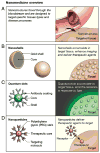Nanoplatforms for constructing new approaches to cancer treatment, imaging, and drug delivery: what should be the policy?
- PMID: 20149882
- PMCID: PMC3524337
- DOI: 10.1016/j.neuroimage.2010.01.105
Nanoplatforms for constructing new approaches to cancer treatment, imaging, and drug delivery: what should be the policy?
Abstract
Nanotechnology is the design and assembly of submicroscopic devices called nanoparticles, which are 1-100 nm in diameter. Nanomedicine is the application of nanotechnology for the diagnosis and treatment of human disease. Disease-specific receptors on the surface of cells provide useful targets for nanoparticles. Because nanoparticles can be engineered from components that (1) recognize disease at the cellular level, (2) are visible on imaging studies, and (3) deliver therapeutic compounds, nanotechnology is well suited for the diagnosis and treatment of a variety of diseases. Nanotechnology will enable earlier detection and treatment of diseases that are best treated in their initial stages, such as cancer. Advances in nanotechnology will also spur the discovery of new methods for delivery of therapeutic compounds, including genes and proteins, to diseased tissue. A myriad of nanostructured drugs with effective site-targeting can be developed by combining a diverse selection of targeting, diagnostic, and therapeutic components. Incorporating immune target specificity with nanostructures introduces a new type of treatment modality, nano-immunochemotherapy, for patients with cancer. In this review, we will discuss the development and potential applications of nanoscale platforms in medical diagnosis and treatment. To impact the care of patients with neurological diseases, advances in nanotechnology will require accelerated translation to the fields of brain mapping, CNS imaging, and nanoneurosurgery. Advances in nanoplatform, nano-imaging, and nano-drug delivery will drive the future development of nanomedicine, personalized medicine, and targeted therapy. We believe that the formation of a science, technology, medicine law-healthcare policy (STML) hub/center, which encourages collaboration among universities, medical centers, US government, industry, patient advocacy groups, charitable foundations, and philanthropists, could significantly facilitate such advancements and contribute to the translation of nanotechnology across medical disciplines.
Copyright © 2010 Elsevier Inc. All rights reserved.
Conflict of interest statement
The authors declare that there are no conflicts of interest.
Figures






References
-
- Abes S, Ivanova GD, Abes R, Arzumanov AA, Williams D, Owen D, Lebleu B, Gait MJ. Peptide-based delivery of steric-block PNA oligonucleotides. Methods Mol Biol. 2009;480:85–99. - PubMed
-
- Adams ML, Lavasanifar A, Kwon GS. Amphiphilic block copolymers for drug delivery. J Pharm Sci. 2003;92:1343–1355. - PubMed
-
- Amoh Y, Katsuoka K, Hoffman RM. Color-coded fluorescent protein imaging of angiogenesis: the AngioMouse models. Curr Pharm Des. 2008;14:3810–3819. - PubMed
-
- Amsharov K, Jansen M. Synthesis of a higher fullerene precursoran “unrolled” C84 fullerene. Chem Commun (Camb ) 2009;19:2691–2693. - PubMed
Publication types
MeSH terms
Substances
Grants and funding
LinkOut - more resources
Full Text Sources

